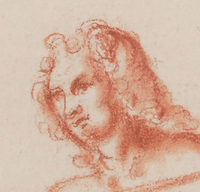|
|
You are not currently logged in. Are you accessing the unsecure (http) portal? Click here to switch to the secure portal. |
Difference between revisions of "Camillo Palladini"
(Fixed link) |
|||
| (11 intermediate revisions by 2 users not shown) | |||
| Line 40: | Line 40: | ||
| below = | | below = | ||
}} | }} | ||
| − | '''Camillo Palladini''' was a 16th or [[century::17th century]] [[nationality::Italian]] fencing master | + | '''Camillo Palladini''' was a 16th or [[century::17th century]] [[nationality::Italian]] fencing master. He seems to have been a professional fencing master, and to have written his [[Discorso sopra l'arte della scherma (MS 14.10)|treatise]] (MS 14/10) around the turn of the 17th century. In the title to his work Palladini declares himself a native of Bologna ("Camillo Palladini Bolognese"), but he also seems to have been active in Rome: [[Torquato d'Alessandri]] named a ''Camillo Paladino'' from Bologna among the masters teaching in Rome as of 1609.<ref>"...the good and honoured masters of Rome, such as Messrs. Oratio and Cesare Cavalcabo, Camillo Paladino [sic], most excellent men, known as the Bolognese; Messers. Francesco and Vincenzo Marcelli, most exquisite men, known as the Abruzzese; and Messrs. Appio Castelli, Gio[vanni]. Angelo Paternostraro and Antonio Rinaldi, most fine and famous men, known as the Romans." [[Torquato d'Alessandri|D’Alessandri, Torquato]]. ''Il cavaliere compito''. Viterbo, 1609. p.109.</ref> |
| + | |||
| + | Palladini’s method of fencing demonstrates commonalities with a number of contemporary and near-contemporary treatises, presaging the methods of later Italian rapier masters while conserving some elements of the earlier Bolognese school (for example cuts or beats with the false edge of the sword, and mentions of the older Bolognese guard names). The treatise covers the sword alone, sword and dagger, sword and cloak, double swords, spadone, pike, and halberd. He also mentions a number of earlier fencing masters in his work, including Tapa di Milano (presumably the “great Tappé of Milan” mentioned by the French chronicler Brantôme) and [[Camillo Agrippa]], whom he cites in order to disagree with, explicitly rejecting overwrought geometrical explanations of fencing. | ||
| + | |||
| + | Palladini’s manuscript was not published in his own lifetime and bears no dedication. However, the 1610 treatise of [[André des Bordes]] appears in large part to be a French translation (without illustrations) of sections of Palladini’s work. | ||
| + | |||
| + | == Treatise == | ||
| + | |||
| − | |||
== Additional Resources == | == Additional Resources == | ||
| − | + | {{bibliography}} | |
== References == | == References == | ||
{{reflist}} | {{reflist}} | ||
| − | {{DEFAULTSORT:Palladini, Camillo}} | + | {{DEFAULTSORT: Palladini, Camillo}} |
__FORCETOC__ | __FORCETOC__ | ||
{{early Italian masters}} | {{early Italian masters}} | ||
| Line 60: | Line 66: | ||
[[Category:Double Side Swords]] | [[Category:Double Side Swords]] | ||
| + | [[Category:Double Rapiers]] | ||
[[Category:Rapier]] | [[Category:Rapier]] | ||
[[Category:Side Sword]] | [[Category:Side Sword]] | ||
[[Category:Sword and Dagger]] | [[Category:Sword and Dagger]] | ||
| − | [[Category:Sword and | + | [[Category:Rapier and Dagger]] |
| + | [[Category:Rapier and Cloak]] | ||
| + | [[Category:Sword and Cloak]] | ||
| + | [[Category:Dagger]] | ||
| + | [[Category:Greatsword]] | ||
| + | [[Category:Staff Weapons]] | ||
Latest revision as of 14:47, 5 February 2024
| Camillo Palladini | |
|---|---|
 | |
| Occupation | Fencing master |
| Influences | Camillo Agrippa |
| Influenced | André des Bordes |
| Genres | Fencing manual |
| Language | Italian |
| Manuscript(s) | MS 14/10 (ca. 1600) |
Camillo Palladini was a 16th or 17th century Italian fencing master. He seems to have been a professional fencing master, and to have written his treatise (MS 14/10) around the turn of the 17th century. In the title to his work Palladini declares himself a native of Bologna ("Camillo Palladini Bolognese"), but he also seems to have been active in Rome: Torquato d'Alessandri named a Camillo Paladino from Bologna among the masters teaching in Rome as of 1609.[1]
Palladini’s method of fencing demonstrates commonalities with a number of contemporary and near-contemporary treatises, presaging the methods of later Italian rapier masters while conserving some elements of the earlier Bolognese school (for example cuts or beats with the false edge of the sword, and mentions of the older Bolognese guard names). The treatise covers the sword alone, sword and dagger, sword and cloak, double swords, spadone, pike, and halberd. He also mentions a number of earlier fencing masters in his work, including Tapa di Milano (presumably the “great Tappé of Milan” mentioned by the French chronicler Brantôme) and Camillo Agrippa, whom he cites in order to disagree with, explicitly rejecting overwrought geometrical explanations of fencing.
Palladini’s manuscript was not published in his own lifetime and bears no dedication. However, the 1610 treatise of André des Bordes appears in large part to be a French translation (without illustrations) of sections of Palladini’s work.
Contents
Treatise
Additional Resources
The following is a list of publications containing scans, transcriptions, and translations relevant to this article, as well as published peer-reviewed research.
- Palladini, Camillo (2019). The Art of Fencing - The Forgotten Discourse of Camillo Palladini. Trans. by Piermarco Terminiello; Joshua Pendragon. Royal Armouries. ISBN 9780948092961.
References
- ↑ "...the good and honoured masters of Rome, such as Messrs. Oratio and Cesare Cavalcabo, Camillo Paladino [sic], most excellent men, known as the Bolognese; Messers. Francesco and Vincenzo Marcelli, most exquisite men, known as the Abruzzese; and Messrs. Appio Castelli, Gio[vanni]. Angelo Paternostraro and Antonio Rinaldi, most fine and famous men, known as the Romans." D’Alessandri, Torquato. Il cavaliere compito. Viterbo, 1609. p.109.

